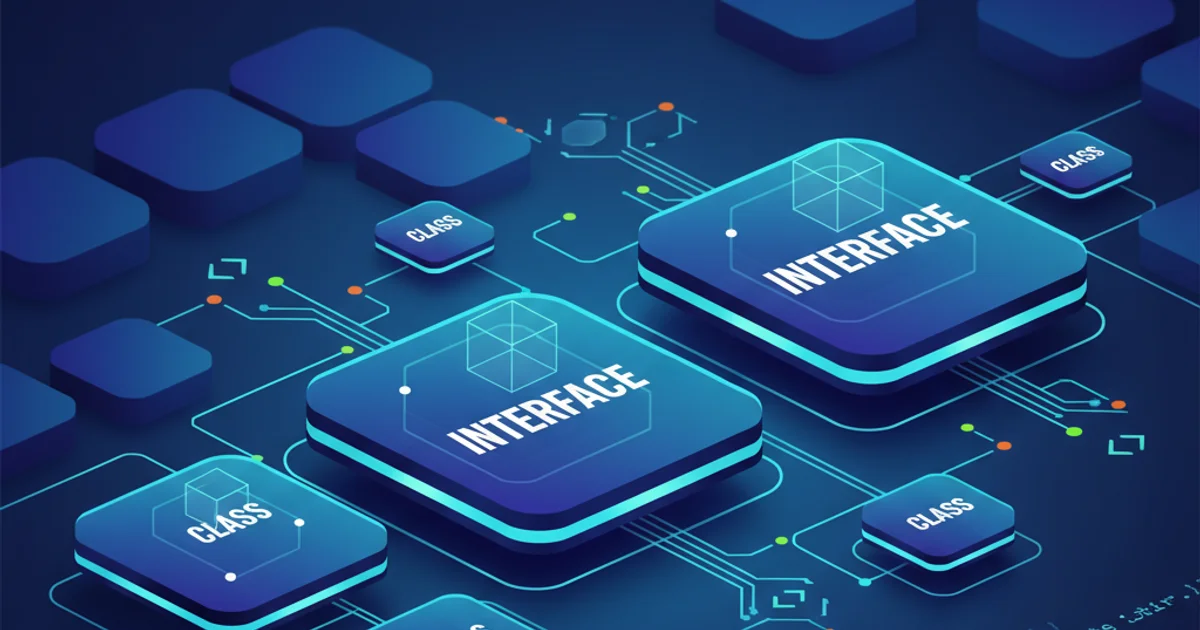Why do we use Interface? Is it only for Standardization?
Categories:
Beyond Standardization: The Multifaceted Role of Interfaces in OOP

Explore the fundamental reasons for using interfaces in Object-Oriented Programming, moving beyond mere standardization to understand their critical role in abstraction, loose coupling, and testability.
In Object-Oriented Programming (OOP), interfaces are a cornerstone concept, often introduced as a mechanism for standardization. While this is certainly a key benefit, limiting our understanding of interfaces to just standardization overlooks their profound impact on software design principles like abstraction, loose coupling, and testability. This article delves into the various reasons why interfaces are indispensable in modern software development.
What is an Interface?
An interface, in its simplest form, is a contract. It defines a set of methods that a class must implement if it claims to adhere to that interface. It specifies what a class should do, without dictating how it does it. Unlike abstract classes, interfaces typically cannot contain implementation details (though some languages have introduced default methods in interfaces). They serve as blueprints for behavior.
classDiagram
interface IShape {
+double getArea()
+double getPerimeter()
}
class Circle {
-double radius
+Circle(radius)
+double getArea()
+double getPerimeter()
}
class Rectangle {
-double width
-double height
+Rectangle(width, height)
+double getArea()
+double getPerimeter()
}
IShape <|.. Circle : implements
IShape <|.. Rectangle : implementsUML Class Diagram illustrating the IShape interface implemented by Circle and Rectangle classes.
Standardization and Contract Enforcement
The most commonly cited reason for using interfaces is indeed standardization. By defining an interface, you establish a common contract that multiple, otherwise unrelated, classes can adhere to. This ensures that any class implementing the interface will provide a specific set of functionalities, making your code more predictable and easier to understand. It's like a formal agreement between different parts of your system.
public interface PaymentProcessor {
void processPayment(double amount);
boolean refundPayment(String transactionId);
}
public class CreditCardProcessor implements PaymentProcessor {
@Override
public void processPayment(double amount) {
System.out.println("Processing credit card payment of " + amount);
}
@Override
public boolean refundPayment(String transactionId) {
System.out.println("Refunding credit card payment: " + transactionId);
return true;
}
}
public class PayPalProcessor implements PaymentProcessor {
@Override
public void processPayment(double amount) {
System.out.println("Processing PayPal payment of " + amount);
}
@Override
public boolean refundPayment(String transactionId) {
System.out.println("Refunding PayPal payment: " + transactionId);
return true;
}
}
Java example demonstrating how PaymentProcessor interface standardizes payment methods.
Achieving Abstraction and Loose Coupling
Beyond standardization, interfaces are crucial for achieving high levels of abstraction and loose coupling. Abstraction allows you to focus on essential details while hiding complex implementations. When you program against an interface, you're interacting with an abstract concept rather than a concrete class. This leads to loose coupling, meaning that components of your system are less dependent on the specific implementation details of other components. If you need to swap out one implementation for another (e.g., change from CreditCardProcessor to PayPalProcessor), the client code that uses the PaymentProcessor interface doesn't need to change, as long as the new class also implements the interface.
flowchart TD
A[Client Code] --> B(PaymentProcessor Interface)
B --> C[CreditCardProcessor Implementation]
B --> D[PayPalProcessor Implementation]
subgraph Loose Coupling
B
endFlowchart showing how client code interacts with an interface, enabling loose coupling with different implementations.
Enabling Polymorphism and Dependency Injection
Interfaces are the backbone of polymorphism in OOP. Polymorphism allows objects of different classes to be treated as objects of a common type (the interface). This is incredibly powerful for writing flexible and extensible code. Furthermore, interfaces are essential for Dependency Injection (DI) and Inversion of Control (IoC) patterns. By injecting dependencies as interfaces rather than concrete classes, you can easily swap out implementations, which is vital for testing and modular design.
public interface ILogger
{
void LogMessage(string message);
}
public class ConsoleLogger : ILogger
{
public void LogMessage(string message)
{
Console.WriteLine($"[Console] {message}");
}
}
public class FileLogger : ILogger
{
public void LogMessage(string message)
{
// Logic to write to a file
Console.WriteLine($"[File] {message}");
}
}
public class ApplicationService
{
private readonly ILogger _logger;
// Dependency Injection via constructor
public ApplicationService(ILogger logger)
{
_logger = logger;
}
public void PerformAction()
{
_logger.LogMessage("Action performed successfully.");
}
}
// Usage:
// ILogger consoleLogger = new ConsoleLogger();
// ApplicationService service1 = new ApplicationService(consoleLogger);
// service1.PerformAction();
// ILogger fileLogger = new FileLogger();
// ApplicationService service2 = new ApplicationService(fileLogger);
// service2.PerformAction();
C# example demonstrating polymorphism and dependency injection using the ILogger interface.
Facilitating Testability
One of the most significant advantages of using interfaces is improved testability. When your classes depend on interfaces rather than concrete implementations, you can easily substitute real dependencies with mock or stub objects during unit testing. This allows you to isolate the class under test and verify its behavior without needing to set up complex environments or interact with external systems (like databases or network services).
In conclusion, while standardization is a valid and important reason for using interfaces, it's merely one facet of their utility. Interfaces are powerful tools for building robust, flexible, and maintainable software systems by promoting abstraction, loose coupling, polymorphism, and testability. Embracing interfaces fully allows developers to design systems that are adaptable to change and easier to manage over their lifecycle.